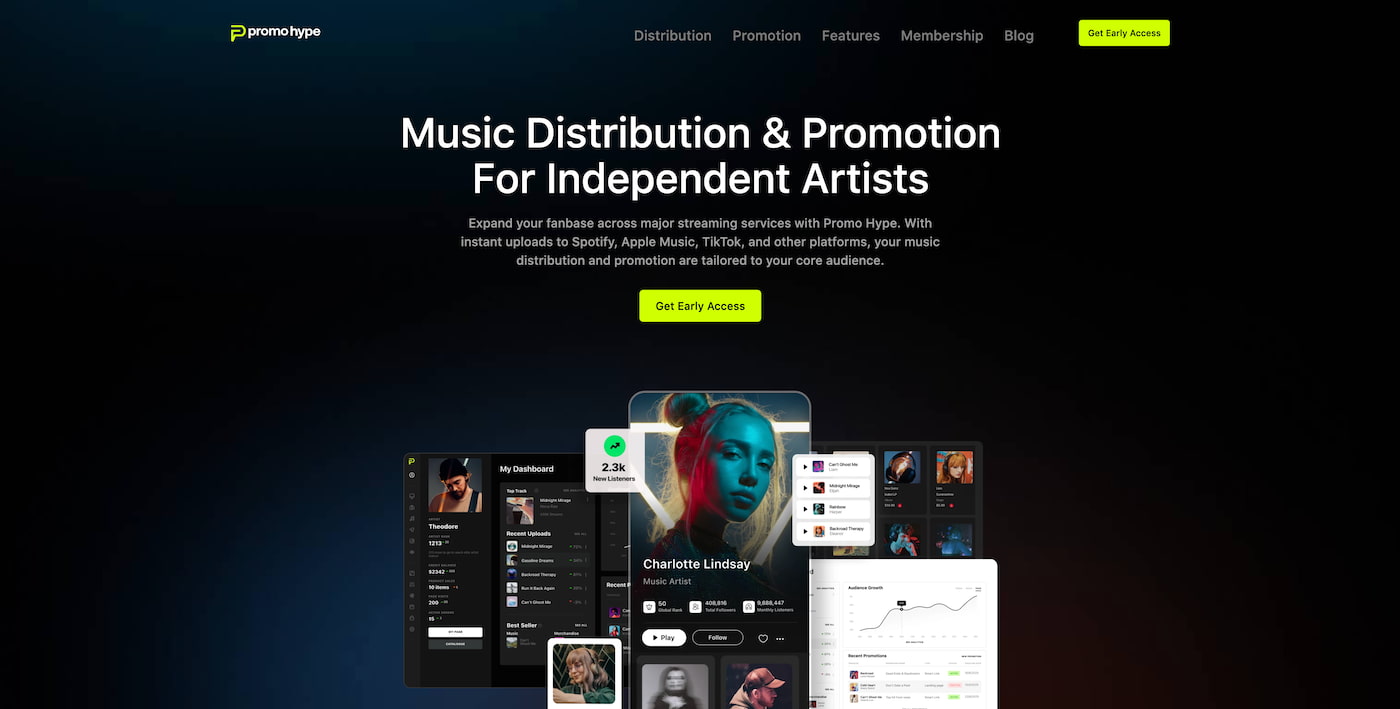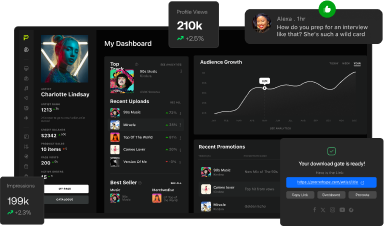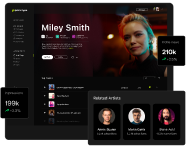
Writing and producing music you’re proud of is the first step toward becoming a successful independent artist.
The best music distribution services help you to realize your ambitions, instantly distributing your tracks across multiple streaming services.
This guide examines the top 10 music distribution services in 2025, detailing their key features, pricing models, and associated fees.
Get Early Access
To Promo Hype
What Is Music Distribution?
Music distribution refers to the process of delivering recorded music to various digital music streaming platforms.
Distribution services were traditionally centered on the physical distribution of records and CDs, typically in brick-and-mortar stores.
However, the modern music distribution landscape has undergone a significant shift toward digital distribution and streaming services.
This has democratized music distribution, enabling independent artists to reach a large audience without relying on label support.
At the same time, this enhanced level of exposure makes it easier for record labels looking for artists to discover new talent.
To facilitate this growth and online presence, the best music distribution services streamline the process of uploading music.
Popular platforms like Spotify, Apple Music, TIDAL, and Amazon Music can all be managed, whether adding back catalogs or new releases.
They offer an affordable option for independent artists to manage their content across multiple platforms and collect royalties.
This allows artists to focus on building relationships with fans, leaving music distribution companies to handle behind-the-scenes tasks.
Free vs. Paid Music Distribution Services
The best music distribution services typically require a fee or a share of royalties to access their full range of features.
However, there are ways independent artists can access free music distribution, which provide limited features compared to paid alternatives.
With no upfront fees or subscription costs, free music distribution services are ideal for new artists with limited budgets.
That said, they typically take a larger cut of revenue from artists and lack the robust marketing services and other tools of major platforms.
The overall quality of completely free music distribution companies can also be lacking, with slower customer support and review times.
As with the best free VST plugins, shopping around is critical for finding a free alternative that covers the necessary services.
Independent artists can utilize free trials for paid music distribution services, allowing them to evaluate tools before signing up.
Learn more about Promo Hype’s features.
The 10 Best Music Distribution Services In 2025
Whether you’re an up-and-coming artist with a new single or an established band, music distribution services are essential for success.
So, with that in mind, here’s our list of the 10 best music distribution services on the market now, examining their promotional tools, fees, and royalty collection protocols.
10. AWAL
Pricing model: $0 upfront, 15% commission
Royalties: 85%
Overview
AWAL music distribution services are provided without any upfront fees, with artists taking 85% of royalties from music streams.
The platform focuses on established artists rather than unknown ones, with a rigorous vetting process for all applicants.
Members retain the creative rights and masters of their home recording studio efforts, and AWAL provides global distribution.
They also offer marketing services and support for artist promotions, helping their members reach a larger audience.
Pros:
- Members can access potential funding or partnerships
- No upfront fees to pay
- Full retention of creative rights
Cons:
- Focusing on vetted artists limits applications
Bottom Line:
With an emphasis on vetting talent and a flat 15% commission rate, AWAL isn’t designed to appeal to all artists.
While there are ancillary costs to be aware of, established acts with a track record may find AWAL suitable for their needs.
9. Record Union
Pricing model: Top Dog (1-2 tracks $14/yr, 3-5 tracks $17/yr, 6-12 tracks $20/yr); World Domination (1-2 tracks $18/yr, 3-5 tracks $24/yr, 6-12 tracks $29/yr)
Royalties: 85%
Overview
In contrast to AWAL, Record Union’s pricing structure is based on the number of releases, such as singles, EPs, and albums.
This is paired with a wide distribution model across major platforms, including Beatport, with a straightforward process for members.
Customer reviews praise the overall level of support Record Union provides, with customizable release pages for artists.
Royalty collection is split automatically; however, some users have reported unexpected fees they weren’t aware of.
Pros:
- Easy-to-use, intuitive platform
- Solid customer support
- Affordable price for limited releases
Cons:
- Per-release payment structure can soon add up
- Lacking advanced analytics and features
Bottom Line:
Artists with extensive back catalogs will likely be deterred by Record Union’s pricing approach, which is based on each upload.
If you’re using the best music production equipment for casual releases, however, the per-release payment might be for you.
8. LANDR
Pricing model: $9 (single)/$19 (album), $23.99–$143.88/year
Royalties: 85% on one-time, 100% on subs
Overview
LANDR is a company that offers a range of services, from tutorials on how to write a song to in-depth music production guides.
The company also serves as a music distributor, with Basic and Pro subscriptions that offer unlimited releases for new artists.
Assisting members with licensing for cover songs, LANDR also helps boost new releases on Shazam, as well as mainstream streaming platforms.
There are also tools for splitting revenue with collaborators and monetizing content through YouTube Content ID collection.
Pros:
- User-friendly platform
- Subscribers retain all royalties
- Unlimited releases
Cons:
- Expensive, particularly for high tiers
- Mastering options are limited
Bottom Line:
A well-known company in the music production community, LANDR’s distribution platform is packed with valuable features.
It’s more expensive than others, and if you want to monetize your social platform, you’ll need to upgrade from the Basic plan.
Read next: Improve your songwriting with this song structure template.
7. Horus Music
Pricing model: £20–£65/release, £20/year (unlimited)
Royalties: 100%
Overview
Another distribution platform that offers unlimited releases with 100% royalties is Horus Music, which includes complete artist control.
Designed for all artists, Horus Music distributes to over 200 platforms, with additional features such as pre-orders and chart registration.
They include additional promotional tools for artists to build an audience, along with analytics to see where their streams are landing.
Phone and email support is available for members, although some have reported hidden fees that weren’t made clear.
Pros:
- Support for all music genres
- Decent range of streaming platforms
- Official UK Charts registration
Cons:
- High takedown costs for removing music
- Lacks mechanical licence guidance
Bottom Line:
Horus Music’s cost-effectiveness applies on a case-by-case basis, with higher prices for those looking to release fewer individual tracks.
UK-based artists seeking to chart success will benefit from the official registration service, while retaining control of their work.
6. ONErpm
Pricing model: No upfront fees/Custom plans
Royalties: 85%
Overview
If you’re entirely new to the music industry, ONErpm’s user-friendly approach to distribution can be a great entry point.
It utilizes a commission-based pricing model, eliminating upfront fees, and provides video distribution and marketing tools for its members.
There are analytics and reporting tools to help drive better outcomes, along with a list of platforms to share your music worldwide.
ONErpm is particularly useful for artists using YouTube for monetization, albeit with a 30% commission for YouTube Content ID earnings.
Pros:
- Robust YouTube monetization
- Easy-too-use interface
- No upfront costs
Cons:
- The submissions process can be slow
- Variable customer service
Bottom Line:
Artists who have completed a music production course and are ready to share their work can access global reach through ONErpm.
While alternatives offer more in-depth tools, the focus on YouTube monetization is ideal for those making videos to support their songs.
Get Early Access
To Promo Hype
5. Ditto Music
Pricing model: $19–$29/year (unlimited uploads)
Royalties: 100%
Overview
With its affordable pricing and access to platforms used by the best music producers, Ditto Music is among the more popular services.
They offer a free 30-day trial period to test their features, with free UP and ISRC Codes provided for all releases.
Ditto Music doesn’t take any percentage of royalties, with unlimited releases and additional label services for those who need them.
Pros:
- Full retention of royalties
- Global reach across many streaming platforms
- Includes free pre-save SmartLinks
Cons:
- Marketing tools are basic
- Potential takedowns when cancelling subscriptions
Bottom Line:
A solid option for artists looking for an affordable distribution platform, Ditto Music is straightforward with unlimited distribution.
If you need more robust marketing tools, however, Ditto Music’s barebones offering may lack the necessary features for promotions.
4. DistroKid
Pricing model: $24.99–$89.99/year
Royalties: 100%
Overview
Another popular platform for artists is DistroKid, which offers unlimited uploads for members based on a flat annual fee.
The platform has recently expanded its services to allow complete video uploads to Spotify for artists who create visual content.
While the basic Musician Plan includes unlimited uploads, you’ll need to upgrade to unlock DistroKid’s entire suite of tools.
Pros:
- Artists keep 100% of royalties
- Spotify Verified checkmark included
- Rapid distribution turnaround
Cons:
- Additional fees for some platforms
- The user interface can be awkward
Bottom Line:
With a focus on up-and-coming artists, DistroKid is a cost-effective option for those who plan to release music frequently.
That said, some members have reported upselling tactics and a lackluster customer support that leads to slow response times.
3. CD Baby
Pricing model: $9.99 (single), $29–$49.99 (album)
Royalties: 91% (store sales), 85% (streaming)
Overview
While some distribution services work on a flat rate, CD Baby opts for fees based on each single or album released.
They support physical distribution, so artists must ensure they’ve mixed their music to the relevant standards before submitting.
Additional services from CD Baby include free UPC and ISRC codes to simplify the process, and song registration with performance rights organizations.
Pros:
- No recurring fees
- Physical distribution options
- Cost-effective for limited release schedules
Cons:
- CD Baby takes a royalty commission
- Processing times can be long
Bottom Line:
With a recent change in leadership, CD Baby has expanded its services to cover alternatives to the standard digital distribution model.
The per-release payment plan won’t suit artists with large music libraries to upload, but it can save money for those with limited songs.
Learn more: Discover the best AI music production tools.
2. TuneCore
Pricing model: Single: $14.99–$49.99/year, Free plan (
Royalties: 100% on paid plans, 85% on the free plan
Overview
Like CD Baby, TuneCore has recently changed its head of operations, with a range of features that artists can use for distribution.
They offer another pay-as-you-go platform along with annual subscriptions, with unlimited distribution when signing up for the subscription.
Members get to retain their royalties, with an easy system for splitting income between collaborators on songs.
Pros:
- Straightforward pricing structure
- Unlimited releases with a subscription
- 100% revenue share for artists
Cons:
- Additional fees and hidden costs
- Features are limited
Bottom Line:
With a clear structure for pricing and unlimited releases, TuneCore is a simple yet effective option, albeit with a limited feature set.
That said, it’s suitable for basic requirements, with the option to get verified on Spotify and Apple Music also included.
1. Promo Hype

Pricing model: Free to join and upload first track, Starter: $19.99/month, Pro: $29.99/month
Royalties: 100%
Overview
A relative newcomer to the list of music distribution platforms, Promo Hype’s services offer a comprehensive suite of tools for artists.
All major streaming and social platforms are covered, with a streamlined interface that makes uploading songs a breeze.
Users can schedule releases, apply promotions, and generate press kits to help market their music to media outlets.
There are also robust analytics tools for monitoring and assessing performance on streaming platforms to drive future decisions.
Pros:
- Unlimited music distribution
- Robust promotional tools
- E-commerce features for additional income
- A thriving community of members
- Free plan available
Cons:
- Video support is not included
Bottom Line:
With no upload limits, a dedicated artist page, and numerous tools, Promo Hype offers members a thorough approach to distribution and promotion.
If you’re hoping to build a global presence and get signed by a record label, Promo Hype’s distribution and promotion tools are a game-changer.
Find out more about Promo Hype’s music distribution services.
What To Consider When Choosing A Music Distribution Service
Navigating the music industry can be challenging, with numerous music distribution services to choose from to get your songs heard.
Once you’ve become a music producer, you can research the best music distribution companies and find one that matches your needs.
Here are some key aspects to consider when choosing a company for your digital music distribution:
- Upfront fees and ongoing subscriptions: The first point to consider is how much you’re willing or able to spend on music distribution services. You can assess music distribution platforms to determine the short- and long-term costs, as well as the revenue percentages you’ll share.
- Music streaming platforms covered: With dozens of music streaming platforms available online, you’ll need to ensure they are distributed to your preferred services. Spotify, TIDAL, Amazon Music, and Apple Music are popular options, along with digital stores like Bandcamp.
- Social media-related music uploads: Many independent artists rely on social media to build their presence and engage with their fans. If you’re using TikTok and Instagram, choose a distribution company that includes music video distribution.
- Customer support reputation: Resolving any issues you have with file formatting or other issues requires clear communication with a distribution platform. Be sure to read through customer reviews to assess the effectiveness of the platform’s support for artists.
- Access to metrics and data analytics: Understanding where your songs are getting the best results is vital for optimizing music marketing strategies. Look for music distribution companies that include robust metrics and analytical tools to help focus your marketing efforts.
Once you’ve prepared songs for digital music distribution, you can consider submitting them to radio stations to strengthen your brand.
Why Use Promo Hype For Music Distribution
Whatever your music genre, partnering with Promo Hype to distribute and promote your music opens up a range of comprehensive services.
Becoming a Promo Hype member helps independent artists reach new fans by:
- Distributing on all major streaming platforms: Reaching a global audience requires a presence on all of the major music streaming platforms. With Promo Hype, you can upload and schedule releases on Spotify, TIDAL, Apple Music, and more.
- Providing access to in-depth promotional tools: Whether you’re playing the long game or hoping to go viral on TikTok, Promo Hype’s promotional tools can help. Use them to manage your marketing campaigns with robust, easy-to-use marketing tools.
- Connecting members with like-minded artists: If you’re seeking collaboration partners or want to hone your songwriting skills, Promo Hype’s Community can help. Members can build their networks and plan upcoming gigs to grow their fan base.
With extensive performance-based metrics and tools to help drive growth, Promo Hype is an essential resource for up-and-coming artists.
Summary
Distributing your music across digital service providers is a crucial step in getting your voice heard above the competition.
By researching the best music distribution services in this guide, you can choose one with a record of supporting independent artists.
As your catalog of great music expands, you can reach out to artists and labels, earning money through publishing royalties.
Get Early Access
To Promo Hype
Join Promo Hype






